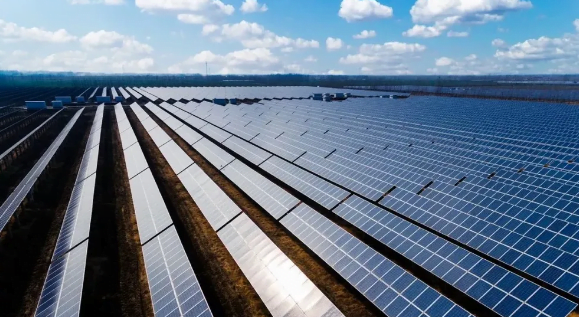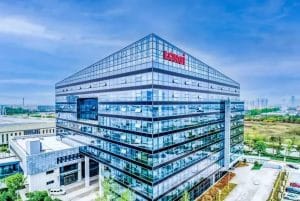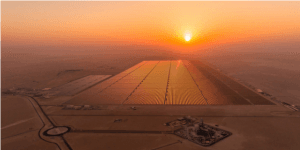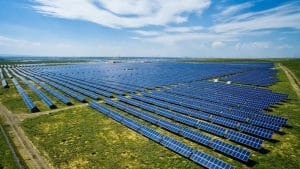01
When will this round of capacity be cleared? This may be the most concerned issue for all those who care about the development of the photovoltaic industry.
So, what are the main obstacles to this round of clearing?
“The clearing of capacity is mainly done by local governments. I think it will be quick if the clearing of backward capacity is left to the market.” At the 2024 Photovoltaic Industry Supply Chain Development (Wenzhou) Conference held on July 24, Lin Jianhua, chairman of Foster, believed that for the healthy development of the industrial chain, the government should not protect backward capacity. “Don’t say that the company has gone bankrupt. Local governments think this is no problem. They give him a guarantee and force the bank to lend him money. The clearing time is slow. If it is left to the market, it will be cleared quickly.”
There are many corporate executives and industry insiders who hold the same view.
“Regarding the current capacity clearance, the capacity has been formed, and the capacity formed in the past one or two years, the equipment level is similar, and there will definitely be a fierce competition process in the future.” At the above meeting, Trina Solar Chairman Gao Jifan said that in this process, it is necessary to follow market rules to better guide the development of the industry. “My suggestion is that when local governments and financial institutions guide the industry to clear out, they should not simply support those companies that are already in trouble or about to be cleared out, but should guide leading companies to merge and merge these companies, promote the accelerated advancement of the industry, break the past scattered situation, and let the industry move towards an orderly and healthy development track. In this way, the capital resources of the whole society invested in the past and in the future can also become more valuable.”
“In the development of our photovoltaic industry, local governments have been too involved and turned many performance photovoltaic projects into performance projects, so performance projects are not easy to stop.” In this regard, Wang Bohua, Honorary Chairman of the China Photovoltaic Industry Association, also said on July 25: “The process of clearing out old and backward production capacity is very difficult.”
However, some industry insiders believe that the speed of clearing out will be too slow if it relies solely on the market.
“I feel that the invisible hand of the market is failing, so at this time our government needs to introduce corresponding policies to intervene accordingly, and work together to maintain the healthy development and sustainable development of the industry or ecology.” Similarly, in the view of Li Shouwei, co-CEO of JA Solar, the country is also issuing some corresponding policies to adjust the industry, including the recently issued standard conditions for the photovoltaic manufacturing industry, which is very good and requires us to work together to maintain it.
Public information shows that in early July, the Ministry of Industry and Information Technology publicly solicited opinions on the draft “Standard Conditions for Photovoltaic Manufacturing Industry (2024 Edition)” (hereinafter referred to as “Standard Conditions”) and “Management Measures for Standard Announcements of Photovoltaic Manufacturing Industry (2024 Edition)” (hereinafter referred to as “Management Measures”).
The newly revised “Standard Conditions” included intellectual property rights for the first time. It pointed out that enterprises are encouraged to strengthen the development, application and protection of intellectual property rights, and establish a sound intellectual property compliance management system in accordance with the “Requirements for Enterprise Intellectual Property Compliance Management System” (GB/T29490).
“The government still needs to get involved.” Lu Chuan, chairman of Zhejiang Chint New Energy, believes that “some guidance is needed in the upstream links, especially the most upstream material links.”
Lu Chuan said that the upstream silicon materials of the photovoltaic industry can be compared with electrolytic aluminum. In the last round of economic cycle, electrolytic aluminum entered a very difficult period after 2010 due to overcapacity, and entered a profitable period in the past two years. It took about 15 years to complete the full capacity reduction.
“If the government does not provide some guidance on the upstream capacity planning and relies entirely on the market to clear, this cycle will be very long. So this includes both the guidance of the overall industrial policy and how local governments can cooperate to do a good job.” Lu Chuan added.
02
In fact, in the last round of excess clearing of the photovoltaic industry, policy-level planning played a very important role.
Around 2008, as photovoltaic companies broke through technical barriers and deployed polysilicon production, China’s polysilicon production continued to grow significantly. However, with the outbreak of the European debt crisis in 2011, coupled with the anti-dumping measures by Europe and the United States, China’s photovoltaic industry suffered a heavy blow, overcapacity became more serious, corporate losses increased, and the industry entered a cold winter.
At that time, domestic polysilicon leading companies such as Daquan and TBEA had basically stopped production, the capacity utilization rate of Asia Silicon and Jiangsu Zhongneng was only about 50%, and LDK Solar completely stopped production. In 2013, A-share listed photovoltaic companies lost a total of about 2.371 billion yuan, and US-listed companies lost a total of about 2.267 billion US dollars. The asset-liability ratio of leading domestic photovoltaic companies such as LDK Solar and Yingli Green Energy soared, and Suntech Power, the world’s largest solar panel manufacturer at the time, announced the bankruptcy of its main subsidiary in China.
But soon, the policy turning point began to arrive.
In December 2012 and June 2013, two State Council meetings studied the photovoltaic industry and formed the “Photovoltaic National Five” and “Photovoltaic National Six” regulatory measures. In July 2013, the State Council issued the “Several Opinions on Promoting the Development of the Photovoltaic Industry”.
From the content point of view, the previous round of policies mainly has three aspects: First, the benchmark electricity price in each region is unified, and the electricity subsidy policy is implemented, which “corrects” the previous project-based subsidies; second, the industrial order is standardized, and key equipment is tested and identified; third, market-oriented mergers and acquisitions are encouraged, and the “white list” of credit support is not strictly set.
In addition, various departments have formulated supporting implementation plans around the “Photovoltaic National Eight”, and have successively issued supporting documents on key photovoltaic projects, technical transformation and industrial upgrading, and mergers and acquisitions.
In terms of financial credit support, in September 2013, the Ministry of Industry and Information Technology issued the “Standardized Conditions for Photovoltaic Manufacturing Industry”, which clarified the industry standards for the first time. The China Development Bank and the China Banking Regulatory Commission successively issued documents to provide credit support for projects that meet the standard documents and large-scale backbone enterprises with excellent assets and core technologies.
In terms of mergers and reorganizations, in December 2014, the Ministry of Industry and Information Technology issued the “Notice on Further Optimizing the Market Environment for Mergers and Reorganizations of Photovoltaic Enterprises”, which formulated detailed arrangements for fiscal, financial and institutional support for mergers and reorganizations in the photovoltaic industry.
In terms of technological transformation, in June 2015, the Ministry of Industry and Information Technology and the National Energy Administration issued the “Opinions on Promoting the Application of Advanced Photovoltaic Technology Products and Industrial Upgrading”, which clearly implemented the “Leader” special plan and formulated standards for photovoltaic products used in government procurement and fiscal and tax subsidy projects.
After the policy was issued, domestic demand started, and the prosperity of the photovoltaic industry stabilized and rebounded.
In 2014, various policies gradually took effect, the prosperity of photovoltaics stabilized, and downstream power stations were better than mid- and upstream manufacturing. In addition, photovoltaic efficiency and energy consumption indicators have been fully improved after the eight photovoltaic national policies. The utilization rate of polysilicon production capacity began to improve, and the price of polysilicon stabilized and rebounded. The overall gross profit margin of the photovoltaic industry also bottomed out and reversed, and the proportion of loss-making enterprises and the debt-to-asset ratio began to decline.
In the end, the photovoltaic industry recovered from all the negative factors in 2015 and rebounded comprehensively.
03
In addition, regarding capacity clearance, some corporate executives believe that accelerating technology iteration is conducive to rapid capacity clearance.
“Overcapacity clearance is a question of who goes in and who goes out, who stays and who goes out.” Chen Gang, chairman of Aixu New Energy, added that “high-efficiency technical products such as n-type batteries BC batteries, if the capacity is generated, can also solve these problems.”
In fact, as of now, the technology iteration of the photovoltaic industry can be roughly divided into four stages, and it has also experienced “four ups and downs”
Before the 1980s, polysilicon technology was not yet mature, and global photovoltaic cell production was mainly based on monocrystalline silicon. After 1980, silicon-based thin-film batteries emerged, and the share of thin-film batteries gradually increased.
From 1996 to 2015, polycrystalline ingot technology was standardized, and the share of polycrystalline silicon batteries expanded rapidly from nearly 30% in 1996 to nearly 70% in 2015. It was also during this period that a wave of polycrystalline silicon module expansion was launched in China, becoming the main hidden danger of the first round of photovoltaic overcapacity.
Finally, facing the current situation of intensified industry reshuffle, many companies have expressed the need to strengthen their own capacity building and not engage in price wars without bottom line.
“In the process of elimination, more companies need to strengthen their strategic determination and do what they should do and what they should not do.” Xiong Haibo, senior vice president of Canadian Solar, said, “Don’t engage in price wars without bottom line.”
“The industry needs to make money to do research and development, quality management, etc., and cannot limit the price and lower the material cost requirements.” Lin Jianhua also holds the same view.
Finally, regarding the timing of this round of clearing, Bloomberg New Energy Finance analyst Tan Youru predicted that the comprehensive supply and demand adjustment will last at least until 2025.
Wu Fei, chairman of Wuxi Suntech Solar and Jingyou Photovoltaic Group, said that this reshuffle will not take too long and will end at the end of next year or the year after. A senior executive of Canadian Solar also said that it is estimated that this round of capacity clearing will end in mid-2025 or the end of the year.




